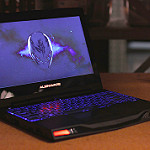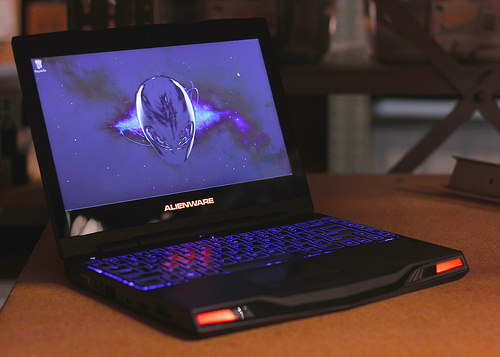 Many people are reporting problems with their monitors turning partly or entirely black, as well as flickering black parts on the screen. This issue often occurs when using applications with heavy graphics, such as pc games, and primarily on laptops.
Many people are reporting problems with their monitors turning partly or entirely black, as well as flickering black parts on the screen. This issue often occurs when using applications with heavy graphics, such as pc games, and primarily on laptops.
Here I explain how to easily solve the issue, and avoid the black screen flickering.
What causes screen flickering?
First of all, we need to understand what causes the screen flickering. This issue is most commonly recognised by:
- Sporadic random flickering when in-game, especially flickering GUI.
- Screen flickering occurs only in some graphic heavy applications.
- No screen problems in windows and often also no issues in game menues.
- Issue primarily occurs on laptops with Intel HD graphics and dedicated GPU.
- Black screen patches on both Nvidia Geforce and AMD Radeon GPUs.
It turns out that the flickering issue is caused by the PC or laptop having both integrated Intel HD graphics, and an additional (much more powerful) dedicated GPU from AMD or Nvidia. Instead of always running on the powerful dedicated GPU (like we used to), newer laptops can now be “smart” and switch between the two. This can make your battery last a little longer, as the integrated graphics consumes less power than the dedicated one. Unfortunately, this can also cause screen flickering, when the system fails to select the powerful GPU for games.
How to get rid of screen flickering
Depending on the model and make of your laptop and GPU, you need to take a different approach to fix the problem. I will explain two possible ways to solve the issue:
- How to fix screen flickering on a pc with Nvidia Geforce graphics
- How to fix screen flickering on a pc with AMD Radeon graphics
If none of these solves your problem, the cause may be a different one. Please leave a comment if one of these approaches solved your flickering problem.
How to fix screen flickering on a pc with Nvidia Geforce graphics
To avoid black screen flickering, you need to configure your PC to use your dedicated Geforce graphics card for the application in which you experience the issue.
- Open the Nvidia Control Panel (eg. by right-clicking on the desktop)
- Go to “Manage 3D settings” and select the “Program settings” tab
- Select the application that has flickering issues in the dropdown menu
- Choose “High performance NVIDIA processor” as the preferred graphics processor
After saving the settings, remember to completely close and restart the application for which you just changed the settings. When you relaunch the application, all screen flickering should now be gone!
If you had trouble completing the four steps, take a look at this guide with screenshots and more details.
How to fix screen flickering on a pc with AMD Radeon graphics
To avoid black screen flickering, you need to configure your PC to use your dedicated AMD Radeon graphics card for the application in which you experience the issue.
- Right-click on the desktop and select “Configure Switchable Graphics”
- Either pick the application with flickering issues from the list of recent applications, of browse to find it yourself
- Make sure that the application has a red box saying “High Performance”, and not the green box saying “Power Saving”
After saving the settings, remember to completely close and restart the application for which you just changed the settings. When you relaunch the application, all screen flickering should now be gone!
If you want to see a video of how to follow these steps, this video takes you through the process of fixing screen flickering for AMD graphics cards:
Photo by aaronmjr

Happens randomly/refresh desktop in win10 all over the place, in explorer if opened, so i doubt this is pure graphic driver problem – its more likely win problem !
What are you supposed to do if it’s all programs? It happens randomly, often when just viewing the desktop. It’s not one specific program, so this fix won’t work.
I started experiencing this issue and noticed my monitor’s display port is partially outside of its housing. Would this cause anything like that? I’m unable to find any mention of pulled ports online so I have no idea what to do.
I try to do this for a game known as roblox, but to no avail, as this setting doesnt pop up, nor does it for any other game.
I have a GTX 1050 TI, by the way.
you might fixed it now by this time.
but your graphics card driver may have problem. If you try your best at the driver.
it might be the problem at the graphics card itself.
Hi mike,
Am experiencing the same issue and it has been really frustrating.
Dell inspiron i5 7559 Intel graphics 530, GTX 960 4gb dedicated.
Well when i chose integrated graphic my games don’t flicker at all tho game are unplayable due to less Intel dedicated graphic memory, when i switch back to Nvidia graphic it flickers n with black, white etc dack screen. I ve searched google and most suggestion aint none working for me,
please advice/help what could be the cause also any solution would be highly appreciated.
Hi,
I can say that for me it worked by choosing to run on only the dedicated graphics card. Maybe it is still in some auto selection mode, since it continues to flicker? Otherwise, you may have other applications running at the same time, which runs on the integrated graphics? If possible, you could try and disable the internal graphics completely, to force all applications to run on the Nvidia card, and then reboot. This would reduce battery time, but might make the flickering problem go away…
Not sure exactly where to do this, though. Best of luck in your troubleshooting.
I am experiencing these issues in program such as calculator or Nvidia Control Panel itself but not on games ! I’ve tried to go High Performance but still flickering ! What could it be else ??